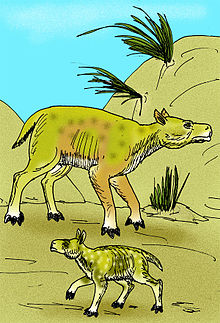- Sespia
-
Sespia
Temporal range: Late OligoceneSespia ultima and S. californica Scientific classification Kingdom: Animalia Phylum: Chordata Class: Mammalia Order: Artiodactyla Family: †Merycoidodontidae Subfamily: †Leptaucheniinae Tribe: †Sespiini Genus: †Sespia
(Stock, 1930)Type species †Sespia nitida Species - †S. californica
- †S. heterodon
- †S. nitida
- †S. ultima
Synonyms - †Megasespia Schultz and Falkenbach, 1968
Sespia ("Sespe") is an extinct genus of terrestrial herbivore of the family Merycoidodontidae, subfamily Merycoidodontinae (an oreodont), endemic to North America during the Whitneyan stage of the Oligocene-Late Oligocene epochs (30.8—24.8 mya) existing for approximately 6 million years.[1]
Contents
Taxonomy
Sespia was named by Schultz and Falkenbach (1968) as a subgenus of Leptauchenia by Stock in 1930; transferred to Cyclopidius by Schlaikjer 1935, Thorpe 1937. Its type is Leptauchenia nitida. It was assigned to Merycoidodontidae by Schultz and Falkenbach (1968) and Lander (1998).[2]
Morphology
Sespia was house cat-sized to goat-sized and desert-dwelling. The genus was closely related to the larger Leptauchenia.
A single specimen was examined by M. Mendoza for body mass and estimated to have a weight of 4.65 kg (10.2 lbs).[3]
Fossil distribution
Fossils of the best known species, the cat-sized S. californica, have been found California, namely, in Chula Vista, and Carlsbad, and is known from literally thousands of specimens. The largest species, the goat-sized S. ultima, is known from late Oligocene deposits in Nebraska. S. ultima was once placed in a separate, monotypic genus, as Megasespia middleswarti. Other species were once placed within Leptauchenia.
Species
S. californica, S. heterodon, S. nitida (syn. Leptauchenia minora, S. marianae), S. ultima (syn. Megasespia middleswarti).
Sister genera
Limnenetes (ancestral) , Leptauchenia (syn. Brachymeryx, Cyclopidius, Hadroleptauchenia, Pithecistes, Pseudocyclopidius)
References
- ^ PaleoBiology Database: Sespia, basic info
- ^ C. B. Schultz and C. H. Falkenbach. 1968. Bulletin of the American Museum of Natural History 139
- ^ M. Mendoza, C. M. Janis, and P. Palmqvist. 2006. Estimating the body mass of extinct ungulates: a study on the use of multiple regression. Journal of Zoology
External links
- [1] San Diego Natural History Museum "Fossil Mysteries Field Guide: Sespia californica

This prehistoric even-toed ungulate-related article is a stub. You can help Wikipedia by expanding it.

